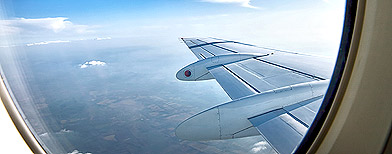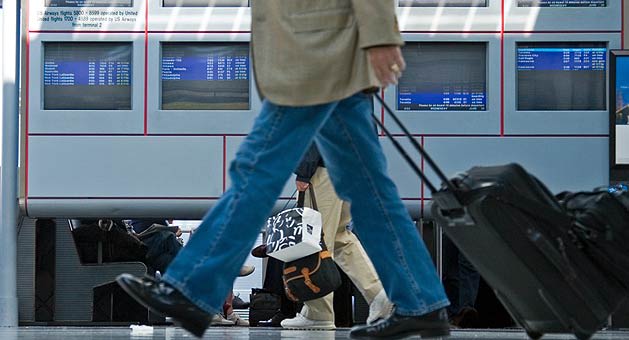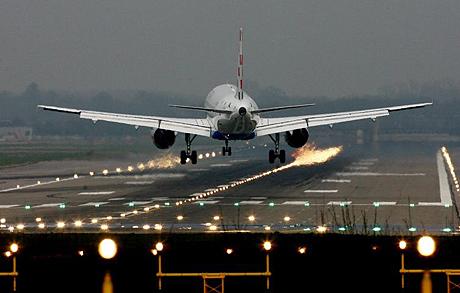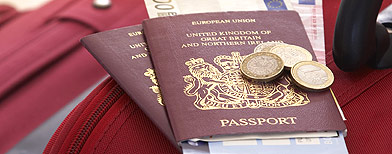
The Sept. 11, 2001, terrorist attacks forever changed the way Americans fly.
Gone are the days when friends or family could kiss passengers
goodbye at the gate, replaced by X-rayed shoes and confiscated shampoo
bottles at security checkpoints.
Air travelers are increasingly subjected to revealing full-body scans
or enhanced pat-downs — all in the name of keeping the skies safe.
As America prepares to mark the 10th anniversary of the worst
terrorist attacks in the U.S.,
security experts question whether
freedom, speed and personal space will one day return to air travel —
while still maintaining high standards of safety.
Some
security analysts foresee a bumper crop of futuristic detection
methods — from biometrics to electronic fingerprinting to behavioral
analysis — and predict smoother, nimbler and less-intrusive airport
walk throughs in the coming years.
Still others envision Big Brother’s even Bigger Brother:
chip-embedded passports that someday tell the federal transportation
watchdogs all about your daily commutes to work, the mall — even to
parties.
Gazing into the future
And then there are experts like Ed Daly who peer into the
next two decades of public
travel and forecast two possible scenarios —
breezy yet virtually
bomb-proof security checkpoints or, depending on
events yet to come, a far harsher reality that includes a
welcome-to-the-airport greeting in the vein of: “Please drop your
drawers if you want to get on this plane.”
“The future of
transportation security will be gathering intelligence
technologically while people are moving at the speed of life, not
beginning at a point where passengers are queued up, delayed, stripped
down and probed,” said Daly, director of intelligence-watch operations
for iJet. The Annapolis, Md.-based firm offers risk-management solutions
for more than 500 multinational corporations and government
organizations.
Daly cites refinements in software that instantly read and catalog
everything from faces to license plates and which, he says, must be
expanded to airports, trains, subways and public buildings.
“[But] if technology fails to provide an adequate solution, the
option in the face of future attacks would be further restrictions and
potential for humiliating human-to-human interaction” rivaling a medical
checkup, Daly said.
Nearly 500 advanced imaging technology machines, commonly referred to
as full-body scanners, are used in 78 airports around the country.
About half (247) use backscatter technology, which emits a small dose of
X-ray radiation to present a detailed image of the body — and any
concealed weapons or contraband a passenger might be carrying. The other
scanners (241) are millimeter-wave machines, which use electromagnetic
waves that also present a detailed body image.
Despite policies the TSA put in place — agents who inspect the
detailed images sit in a room away from scanned passengers, and the
TSA’s insistence that the images cannot be stored or shared — many
travelers argue the full-body scanners are an invasion of privacy.
In response, the TSA has begun implementing software on the millimeter-wave machines that will highlight dangerous items but will not show detailed, passenger-specific images.
Meanwhile, other critics — including some scientists — claim the scanners are a health risk, and say there hasn’t been sufficient testing to ensure they won’t cause potential harm.
Behavioral questioning
The
Transportation Security Administration is currently testing behavioral questioning
at Boston’s Logan Airport. Behavior detection officers initiate
conversations with all passengers passing through Terminal A, asking
non-intrusive questions and watching for responses. Fliers who avoid eye
contact or who wrestle to answer certain questions may be pulled out of
line for extra scrutiny.
The pilot program is “modeled after a number of behavior-detection
programs used by other
security and law-enforcement agencies, but
tailored to TSA’s specific mission,” said TSA spokesperson Greg Soule.
Frequent flier Andrew Schrage argues that this new approach “crosses
into people’s (personal) lives.” “That leaves too much up to the
subjectivity of the inquirer,” said Schrage, the Chicago-based editor of
MoneyCrashers.com, a personal finance blog. He flies about 20 times per
year. “It will also act as a further invasion into people’s privacy.”
He anticipates that during the next few years
airport security will grow
“more and more cumbersome.”
Trusted travelers
The “known traveler program” will be tested this fall
by the TSA at airports in Dallas, Miami, Atlanta and Detroit. At those
hubs, the TSA will tap into the information ticket buyers have already
provided the airlines, including their names, dates of birth and gender.
Ultimately, approved “known travelers” will have bar codes stamped on
their boarding passes, authorizing TSA screeners to allow those
passengers to skip shoe and
laptop removals.
"Enhancing identity-based screening is another common sense step in
the right direction as we continue to strengthen overall security and
improve the passenger experience whenever possible," TSA Administrator
John Pistole said in July.
Are we there yet?
One long-discussed hybrid of the “known traveler” program
is the “Checkpoint of the Future,” a plan to make screening stops
quicker and technologically “smarter,” freeing up TSA agents to “scan
the crowd, looking for individuals that could pose an outright threat,”
said Peter Kant, executive vice president of Rapiscan Systems, a
Hawthorne, Calif., company that provides the TSA with
passenger-screening equipment, including the backscatter machine.
In June, the International Air Transport Association
unveiled a mockup of the idea
— three sensor-lined tunnels that divide passengers into high, medium and low risks.
On Aug. 10, the TSA’s Pistole said such checkpoints “would allow you
to keep your jacket and shoes on,” although he acknowledged the
necessary technology is “not there yet.”
“Specifically, (when and if that machinery is someday implemented),
passengers will notice a much more automated and more intuitive
process,” said Rapiscan’s Kant. “Annoying divestiture of jackets,
liquids and computers will no longer be required. Easy-to-use conveyors
and bins will allow for swift scanning of bags






